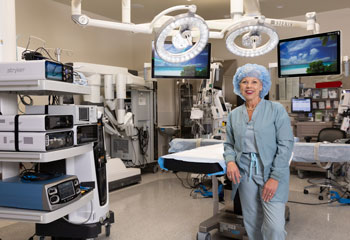Minimally Invasive Thoracic Surgery (VATS)
Video-assisted thoracoscopic surgery (VATS) is a minimally invasive surgical technique that is used to diagnose and treat a variety of conditions within the chest cavity. Compared with traditional thoracic procedures, the VATS technique offers considerable benefits to patients.
Benefits of video-assisted thoracic surgery (VATS)
Before minimally invasive thoracic techniques were developed, surgeons relied on large open thoracotomies to access the chest cavity.
Thoracotomy requires a large incision in the chest, breaking and spreading of multiple ribs, and extensive tissue damage in order to simply reach the inner chest cavity.
VATS, on the other hand, is performed with the use of high-tech camera-equipped instruments through a few small incisions in the chest. There is no breaking or spreading of the ribs using VATS. Unfortunately, many surgeons are not fully trained in advanced VATS techniques, especially VATS lobectomy, which is the gold standard for early stage lung cancer treatment.
The advantages of VATS for patients are substantial, and for this reason our surgeons utilize minimally invasive thoracic surgery virtually all of the time.
Benefits include:
- Reduced scarring
- Decreased postoperative pain
- Shorter hospital stay
- Lower risk of complications
- Better overall surgical outcomes
- Reduced immunosupression following surgery
How is VATS performed?
Video-assisted thoracoscopic surgery is performed by a surgeon, along with a highly trained team of surgical staff and anesthesiologists.
Under general anesthesia, three or four small incisions (1-2 cm) are made in the chest cavity and a tiny camera called a thoracoscope is inserted between the ribs and into the chest. This instrument transmits live video feed from within the chest to monitors in the operating room, which our surgeons can view throughout the entire surgery.
Additional instruments are inserted through the other incisions to carry out the specific procedure.
The incisions remain small and the ribs are never broken and/or spread. Once complete, the instruments and camera are removed and the incisions are closed with sutures.
What VATS can treat
Our surgeons are able to treat a wide variety of thoracic conditions with advanced VATS techniques, including:
- Lobectomy and mediastinal lymph node dissection for lung cancer
- Wedge resection for solitary pulmonary nodules
- Wedge resection for pulmonary metastases
- Pneumonectomy for lung cancer
- Esophageal mobilization for esophageal cancer
- Thymectomy for myasthenia gravis
- Decortication for empyema (infection within the pleural space)
- Lung volume reduction surgery for emphysema
- Talc pleurodesis for recurrent benign or malignant pleural effusions
- Insertion of pleurex catheters for recurrent effusions
- Bleb resection and mechanical pleurodesis for recurrent pneumothoraces
- Thoracic sympathectomy for hyperhidrosis (excessive sweating)
- First rib resection for thoracic outlet syndrome
- Heller myotomy for achalasia
To learn more about Thoracic Surgery Services, call 714-456-8000.








